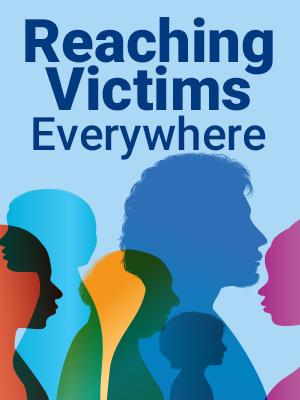Archival Notice
This is an archive page that is no longer being updated. It may contain outdated information and links may no longer function as originally intended.
Innovative Practices
According to the National Crime Victimization Survey, only 8 percent of victims of violent crimes received help from a victim service agency in 2019—a decline of 11 percent from 2018. To improve this reality, the victim services field must diversify and expand existing strategies for providing victim assistance and create vital links to other fields that come into contact with victims of crime. During FYs 2019 and 2020, OVC offered several funding opportunities to stimulate the field’s efforts in these areas, and several projects initiated in previous years reached their implementation stages.
Hospital-Based Violence Intervention Programs
In FY 2018, under the Advancing Hospital-Based Victim Services program, OVC made nine awards totaling almost $9.4 million to eight demonstration sites to implement and expand hospital-based and affiliated programs to support crime victims using evidence-based models and practices with victim-centered approaches. The program also funded a technical assistance (TA) provider to support the demonstration sites. Each site is working to expand the use of hospitals and other medical facilities as entry points to increased support for victims of crime, improve their outcomes, and prevent chances for repeat victimization.
Between FYs 2019 and 2020, demonstration sites averaged 41 partners per quarter, with an average of 25 partners per quarter using evidence-based practices. These evidence-based practices included the trauma-informed care Hospital-based Violence Intervention Program (HVIP) model to decrease the risk of return to the criminal justice system; cognitive-processing therapy for female victims of sexual assault; the use of Sexual Assault Nurse Examiners; and multidisciplinary team model practices. During the same time period, the demonstration sites implemented 199 improvement initiatives and completed 78 project deliverables.
A total of 3,282 new victims were served across the 8 demonstration sites. The most common types of victimization included adult physical assault, child sexual abuse, and survivors of homicide. Frequently provided services included referrals to other services, supports, and resources (3,303 occurrences); crisis intervention (1,847 occurrences); referrals to victim service providers (1,830); and individual counseling (1,606 occurrences).
The training and technical assistance (TTA) provided varied depending on the individual grantees’ needs and requests. Some of the more common topics included building trauma-informed workplaces, addressing vicarious trauma and staff burnout, creating survivor-centered partnerships with law enforcement, ensuring access to language assistance, and racial equity. The TA provider also hosted a monthly “community of practice,” during which participants discussed a specific topic or issue that was raised by grantees during site visits or monthly check-in calls. The TA provider conducted 42 trainings for 1,286 participants, and completed 354 TA requests with 1,090 recipients.
Support to State Administrating Agencies
During FY 2020, the TA provider began working on a toolkit for policymakers and Victims of Crime Act (VOCA) State Administrating Agencies (SAA) responsible for producing coordinated approaches to victim assistance in their respective jurisdictions. The goal of the toolkit is to encourage these stakeholders to more effectively incorporate public health strategies for victims of crime into their work and grantmaking.
In an effort to identify gaps in victim services and increase access to resources for crime victims in rural/tribal areas, older victims, and victims of violent crime, OVC implemented the State Victim Liaison Project in FY 2020. Crime victim liaisons were placed in 10 VOCA SAAs to act as a bridge between the state and other state-based non-governmental organizations to identify gaps in victim services and improve and increase access to resources for crime victims in rural/tribal areas, older victims, and victims of violent crime. The liaisons use their statewide networking connections to facilitate effective interactions with community leaders, allied professionals, and community stakeholders to achieve the objectives of this project.
Technology To Assist Victims of Crime
OVC’s Advancing the Use of Technology to Assist Victims of Crime Program supports grantees in developing innovative strategies to create, expand, or enhance the use of technology initiatives to improve responses to, and services and access for, victims of crime. First released in FY 2017, OVC has since funded 25 grant awards totaling more than $36.2 million—including 10 awards totaling $14.8 million in FYs 2019 and 2020—for organizations to provide access to victim services in areas where local or accessible services are not sufficient to meet the needs of the community.
Grantees are using grant funds to enhance the National Sexual Assault Online Hotline, expand VictimConnect's services, extend the StrongHearts Native Helpline's hours of operation and implement digital (chat) services, develop a toolkit for transitioning victim service providers to teleservice, and increase the capacity of the National Domestic Violence Hotline’s current provider database by adding the ability to track the availability of shelter beds nationwide, among many other initiatives.
Between FYs 2019 and 2020, grantees completed 201 system-level IT improvements and developments and trained 790 program staff members on the technology improvements. In addition, grantees implemented 161 planned improvements and completed 324 project deliverables. Completed planning documents include action plans, data collection plans, and both internal and community-focused needs/strengths assessments.
In FY 2019, OVC released a similar program for VOCA Formula SAAs. Through the Building State Technology Capacity and Elder Abuse Hotlines program, eight grantees are implementing statewide technology programs to enhance victims’ access to services, foster innovation and efficiency in the provision of services, improve the quality of services, and improve the accessibility and responsiveness of victim service organizations. In FY 2020, the 8 grantees completed 135 system-level IT improvements and developments and trained 59 program staff on the technology. They also implemented 32 improvement initiatives and completed 23 project deliverables, including completion of a data analysis needs assessment, expansion/enhancement of several statewide Automated Victim Information and Notification programs, improved elder abuse reporting systems to expand services to older victims of abuse and neglect, updated victim compensation claim databases to pay victims in a more timely manner, and the launch of one state’s new elder abuse hotline.
OVC continues building on its support for telehealth initiatives to provide victims of sexual assault with specialized medical practices such as forensic exams. In FY 2016, OVC first provided funding under the Using Telemedicine Technology to Enhance Access to Sexual Assault Forensic Exams program, through which Pennsylvania State University (PSU) developed and implemented the Pennsylvania Sexual Assault Forensic Examination and Training (SAFE–T) Center. The SAFE–T Center provided telehealth support to four pilot sites in Pennsylvania—Penn Highlands DuBois in Clearfield County, Soldiers and Sailors Memorial Hospital in Wellsboro, Penn Highlands Huntingdon Hospital in Huntingdon, and Clarion Hospital in Clarion. Through telehealth technology, expert nurses can observe exams in progress at these sites, ensuring best practices, proper evidence collection, and a safe, helpful environment for the victim.
In FY 2019, OVC awarded grants totaling nearly $18 million to four demonstration sites and one TA provider under the Using Telehealth to Improve Care, Access and Quality of Sexual Assault Forensic Exams program. The demonstration sites (Texas A&M University’s Texas Teleforensic Remote Assistance Center, Avera Health’s eSANE for Rural program, Tundra Women’s Coalition Yukon-Kuskokwim TeleSAFE Project, and the University of Arkansas’ Sexual Assault Forensic Examiner Network for Evidence-based Telemedicine) joined Penn State University (SAFE–T Center) to increase access to high-quality forensic care for victims of sexual assault in rural and underserved areas.
In FY 2020, the 4 demonstration sites completed 5 system-level IT improvements and trained 18 staff members on the new technology. These sites work with an average of 39 partners per quarter, with an average of 12 partners per quarter using evidence-based programs or practices. Common programs and practices implemented include SANE training, Eye-Movement Desensitization and Reprocessing therapy, and Trauma-Focused Cognitive Behavioral Therapy. The International Association of Forensic Nurses was awarded funding ($2.2 million) to provide TA to the demonstration sites as they began planning and implementing their telehealth programs. In FY 2020, four trainings were conducted for 75 participants, including victim advocates and medical professionals/health care providers. The TA provider responded to 153 TTA requests, with 972 recipients; completed 14 data-gathering initiatives; and disseminated 33 informational resources.
Also in FY 2019, OVC funded a 3-year program to address elder abuse and financial exploitation under the Field-Generated Solutions for Tribal and Non-Tribal Communities to Improve Services for Victims of Crime: Innovations in Telehealth program. OVC competitively funded the New York City Department for the Aging, in partnership with Weill Cornell Institute of Geriatric Psychiatry, to deliver an internationally recognized evidence-based mental health intervention to elder abuse victims and victims of crimes committed by strangers, who screen positive for depression. The Tele-PROTECT (Providing Options To Elderly Clients Together) program offers a psychotherapy treatment program remotely and efficiently, using a secure internet platform to communicate with senior victims.
The Tele-PROTECT program served 3,106 anonymous contacts in FY 2020. The most common victimizations reported were adult sexual assault, adult physical assault, and domestic and family violence. The main services provided were hotline/crisis line counseling (2,609 occurrences) and referrals to victim service providers (1,421 occurrences). The program grantee conducted 9 trainings for 361 participants, including victim service providers and victim advocates. They also completed 223 TTA requests, with 441 recipients.




